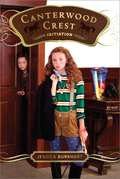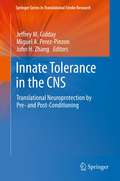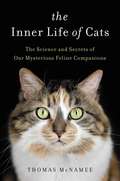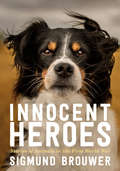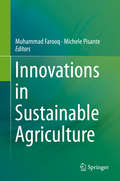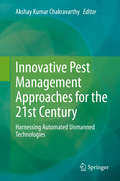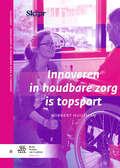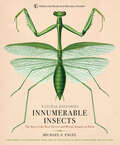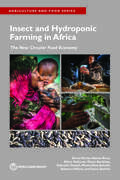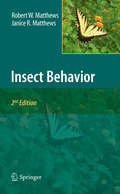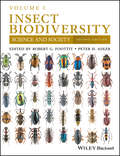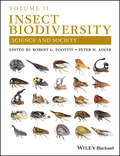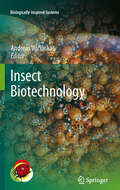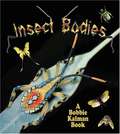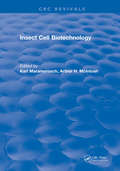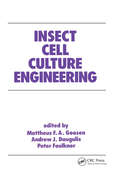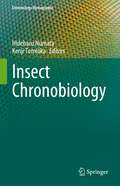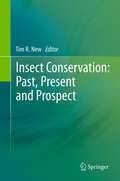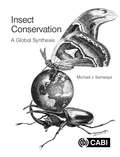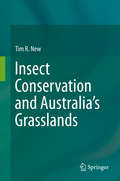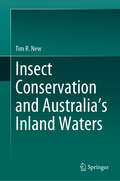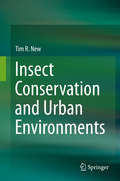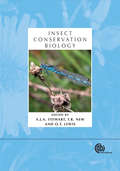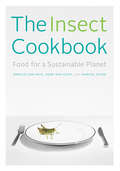- Table View
- List View
Initiation
by Jessica BurkhartIt's time: The new girls are taking the spotlight at Canterwood Crest!Lauren has moved around enough to have the "new girl" code down:1. Lay low.2. But not too low.3. Don't amubush the in crowd.But Canterwood isn't just any school. And Lauren is about to face an initiation unlike any she's ever encountered. Bon chance, Lauren--you're going to need it!
Inky: The Seeing Eye Dog
by Elizabeth P. HeppnerMore than anything in the world, Jonathan wants a dog. Then he finds a frisky puppy in the woods. But Inky already has an owner--the Seeing Eye. Jonathan is crushed until the man who has come for Inky asks, "Jonathan, how would you like to take care of Inky for the next twelve months?"
Innate Tolerance in the CNS
by Miguel A. Perez-Pinzon John H. Zhang Jeffrey M. GiddayCerebral preconditioning is a phenomenon wherein a mild insult or stress induces cellular and tissue adaptation or tolerance to a later, severe injury, therefore reflecting the efficacy of endogenous mechanisms of cerebrovascular protection. Initially identified for rapid cardiac protection, preconditioning has expanded to all aspects of CNS protection from ischemia, trauma and potentially neurodegeneration. Many different stimuli or stressors have been identified as preconditioning agents, suggesting a downstream convergence of mechanisms and underscoring the potential for translational application of preconditioning in the clinic. Moreover, the fundamental mechanisms responsible for preconditioning-induced tolerance will help in the design novel pharmacological approaches for neuroprotection. While stroke and many other brain injuries are not predictable, in some populations (e.g., metabolic syndrome, patients undergoing carotid endarterectomy, aneurysm clipping, or with recent TIAs) the risk for stroke is identifiable and significant, and preconditioning may represent a useful strategy for neuroprotection. For unpredictable injuries, post-conditioning the brain - or inducing endogenous protective mechanisms after the initial injury - can also abrogate the extent of injury. Finally, remote pre- and post-conditioning methods have been developed in animals, and are now being tested in clinical trials, wherein a brief, noninjurious stress to a noncerebral tissue (i.e., skeletal muscle) can provide protection to the CNS and thereby allows clinicians the opportunity to circumvent concerns regarding the direct preconditioning of neurological tissues.
The Inner Life of Cats: The Science And Secrets Of Our Mysterious Feline Companions
by Thomas McnameeOur feline companions are much-loved but often mysterious. In The Inner Life of Cats, Thomas McNamee blends scientific reportage with engaging, illustrative anecdotes about his own beloved cat, Augusta, to explore and illuminate the secrets and enigmas of her kind. As it begins, The Inner Life of Cats follows the development of the young Augusta while simultaneously explaining the basics of a kitten's physiological and psychological development. As the narrative progresses, McNamee also charts cats' evolution, explores a feral cat colony in Rome, tells the story of Augusta's life and adventures, and consults with behavioral experts, animal activists, and researchers, who will help readers more fully understand cats. McNamee shows that with deeper knowledge of cats' developmental phases and individual idiosyncrasies, we can do a better job of guiding cats' maturation and improving the quality of their lives. Readers' relationships with their feline friends will be happier and more harmonious because of this book.
Innocent Heroes: Stories of animals in the First World War
by Sigmund BrouwerA unique celebration of the important role animals play in war, and an insightful look at the taking of Vimy Ridge from the perspective of 3 men in a Canadian platoon.Never before have the stories of animal war heroes been collected in such a special way. This book consists of eight connected fictional stories about a Canadian platoon in WW1. The Storming Normans have help from some very memorable animals: we meet a dog who warns soldiers in the trench of a gas attack, a donkey whose stubbornness saves the day, a cat who saves soldiers from rat bites, and many more. Each story is followed by nonfiction sections that tell the true story of these animals from around the world and of the Canadian soldiers who took Vimy Ridge. Through the friendship that grows between three of these soldiers in particular, we get a close-up look at life in the trenches, the taking of Vimy Ridge, the bonds between soldiers and their animals and what it meant to be Canadian in WW1.From the Hardcover edition.
Innovations in Sustainable Agriculture
by Muhammad Farooq Michele PisanteThis volume is a ready reference on sustainable agriculture and reinforce the understanding for its utilization to develop environmentally sustainable and profitable food production systems. It describes ecological sustainability of farming systems, present innovations for improving efficiency in the use of resources for sustainable agriculture and propose technological options and new areas of research in this very important area of agriculture.
Innovative Pest Management Approaches for the 21st Century: Harnessing Automated Unmanned Technologies
by Akshay Kumar ChakravarthySeveral Integrated Pest Management (IPM) approaches are available for managing pests of varied kinds, including individual and integrated methods for pest suppression. Recently the focus has shifted to pest management tools that act on insect systems selectively, are compatible with the environment, and are not harmful for ecosystems. Other approaches target specific biochemical and physiological aspects of insect metabolism, and involve biotechnological and genetic manipulation. Still other approaches include the use of nanotechnology, endophytes, optical and sonic manipulation to detect and control pest insects. Unfortunately, conventional forms of pest management do not focus on technology transfer to the ground level workers and farmers. As a result, farmers are incurring huge losses of crops and revenues. This book highlights the importance of using communication tools in pest management and demonstrates some success stories of utilizing automated unmanned technologies in this context. The content is divided into three sections, the first of which, “Pest Population Monitoring: Modern Tools,” covers long and short-range pest population monitoring techniques and tools such as satellites, unmanned aerial vehicles/drones, remote sensing, digital tools like GIS, GPS for mapping, lidar, mobile apps, software systems, artificial diet designs and functional diversity of info-chemicals. The second section of the book is devoted to “Emerging Areas in Pest Management” and offers a glimpse of diversified tactics that have been developed to contain and suppress pest populations such as endophytes, insect vectors of phytoplasma, Hymenopterans parasitoids, mass production and utilization of NPV etc. In turn, the third section focuses on “Integrated Pest Management” and presents farming situations that illustrate how research in diversified aspects has helped to find solutions to specific pest problems, and how some new and evolving tactics can be practically implemented. Given its scope, the book offers a valuable asset for entomology and plant pathology researchers, students of zoology and plant protection, and readers whose work involves agriculture, horticulture, forestry and other ecosystems.
Innoveren in houdbare zorg is topsport
by Robbert Huijsmanhet boek bevat een slectie van weblogs van de hand van Robbert Huijsman over het anders en slimmer organiseren van de zorg. Eerder gepubliceerd op Skipr.nl in periode 2009-2013.
Innumerable Insects: The Story of the Most Diverse and Myriad Animals on Earth (Natural Histories)
by Michael S. EngelA fascinating look at the world’s most numerous inhabitants—with stunning images from the American Museum of Natural History’s Rare Book Collection.“As aesthetically pleasing as it is informative . . . The images, however, are the stars of this work, which will delight every entomophile who turns its pages.” —Publishers WeeklyTo date, we have discovered and described or named around 1.1 million insect species, and thousands of new species are added to the ranks every year. It is estimated that there are around five million insect species on Earth, making them the most diverse lineage of all life by far. This magnificent volume from the American Museum of Natural History tells their incredible story. Noted entomologist Michael S. Engel explores insects’ evolution and diversity; metamorphosis; pests, parasites, and plagues; society and language; camouflage; and pollination—as well as tales of discovery by intrepid entomologists. More than 180 illustrations from the Rare Book Collection at the Museum’s Research Library reveal the extraordinary world of insects down to their tiniest, most astonishing details, from butterflies’ iridescent wings to beetles’ vibrant colors.“Engel explores the identification and classification of insects, along with habitat, habits, and life cycles . . . Even the drawing of a giant cave cockroach (not native to the United States!) is captivating . . . engrossing.” —Library Journal
Insect and Hydroponic Farming in Africa: The New Circular Food Economy (Agriculture and Food Series)
by Dorte Verner Nanna Roos Afton Halloran Surabian Maximillian Ashwill Saleema Vellani Yasuo KonishiInterestingly, some relief from today's woes may come from ancient human practices. While current agri-food production models rely on abundant supplies of water, energy, and arable land and generate significant greenhouse gas emissions in addition to forest and biodiversity loss, past practices point toward more affordable and sustainable paths. Different forms of insect farming and soilless crop farming, or hydroponics, have existed for centuries. In this report the authors make a persuasive case that frontier agriculture, particularly insect and hydroponic farming, can complement conventional agriculture. Both technologies reuse society's agricultural and organic industrial waste to produce nutritious food and animal feed without continuing to deplete the planet's land and water resources, thereby converting the world's wasteful linear food economy into a sustainable, circular food economy. As the report shows, insect and hydroponic farming can create jobs, diversify livelihoods, improve nutrition, and provide many other benefits in African and fragile, conflict-affected countries. Together with other investments in climate-smart agriculture, such as trees on farms, alternate wetting and drying rice systems, conservation agriculture, and sustainable livestock, these technologies are part of a promising menu of solutions that can help countries move their land, food, water, and agriculture systems toward greater sustainability and reduced emissions. This is a key consideration as the World Bank renews its commitment to support countries' climate action plans. This book is the Bank's first attempt to look at insect and hydroponic farming as possible solutions to the world's climate and food and nutrition security crisis and may represent a new chapter in the Bank's evolving efforts to help feed and sustain the planet.
Insect Behavior
by Janice R. Matthews Robert W. MatthewsThis book offers a comprehensive overview of fundamental concepts of animal behavior as they relate to insects. Considerably updated and expanded, this new edition includes 26 case studies, as well as 45 new color plates and 173 figures (over 40% of them new) with detailed legends that add richness to the well-written, accessible text.
Insect Biodiversity: Science and Society, Volume 1
by Peter H. Adler Robert G. FoottitVolume One of the thoroughly revised and updated guide to the study of biodiversity in insects The second edition of Insect Biodiversity: Science and Society brings together in one comprehensive text contributions from leading scientific experts to assess the influence insects have on humankind and the earth’s fragile ecosystems. Revised and updated, this new edition includes information on the number of substantial changes to entomology and the study of biodiversity. It includes current research on insect groups, classification, regional diversity, and a wide range of concepts and developing methodologies. The authors examine why insect biodiversity matters and how the rapid evolution of insects is affecting us all. This book explores the wide variety of insect species and their evolutionary relationships. Case studies offer assessments on how insect biodiversity can help meet the needs of a rapidly expanding human population, and also examine the consequences that an increased loss of insect species will have on the world. This important text: Explores the rapidly increasing influence on systematics of genomics and next-generation sequencing Includes developments in the use of DNA barcoding in insect systematics and in the broader study of insect biodiversity, including the detection of cryptic species Discusses the advances in information science that influence the increased capability to gather, manipulate, and analyze biodiversity information Comprises scholarly contributions from leading scientists in the field Insect Biodiversity: Science and Society highlights the rapid growth of insect biodiversity research and includes an expanded treatment of the topic that addresses the major insect groups, the zoogeographic regions of biodiversity, and the scope of systematics approaches for handling biodiversity data.
Insect Biodiversity: Science and Society
by Robert G. Foottit Peter H. AdlerVolume Two of the new guide to the study of biodiversity in insects Volume Two of Insect Biodiversity: Science and Society presents an entirely new, companion volume of a comprehensive resource for the most current research on the influence insects have on humankind and on our endangered environment. With contributions from leading researchers and scholars on the topic, the text explores relevant topics including biodiversity in different habitats and regions, taxonomic groups, and perspectives. Volume Two offers coverage of insect biodiversity in regional settings, such as the Arctic and Asia, and in particular habitats including crops, caves, and islands. The authors also include information on historical, cultural, technical, and climatic perspectives of insect biodiversity. This book explores the wide variety of insect species and their evolutionary relationships. Case studies offer assessments on how insect biodiversity can help meet the needs of a rapidly expanding human population, and examine the consequences that an increased loss of insect species will have on the world. This important text: Offers the most up-to-date information on the important topic of insect biodiversity Explores vital topics such as the impact on insect biodiversity through habitat loss and degradation and climate change With its companion Volume I, presents current information on the biodiversity of all insect orders Contains reviews of insect biodiversity in culture and art, in the fossil record, and in agricultural systems Includes scientific approaches and methods for the study of insect biodiversity The book offers scientists, academics, professionals, and students a guide for a better understanding of the biology and ecology of insects, highlighting the need to sustainably manage ecosystems in an ever-changing global environment.
Insect Biotechnology
by Andreas VilcinskasThe book provides a fascinating overview about current and sophisticated developments in applied entomology that are powered by molecular biology and that can be summarized under a novel term: insect biotechnology. By analogy with the application of powerful molecular biological tools in medicine (red biotechnology), plant protection (green biotechnology) and industrial processing (white biotechnology), insect biotechnology (yellow biotechnology) provides novel tools and strategies for human welfare and nutrition. Insect Biotechnology has emerged as a prospering discipline with considerable economic potential, and encompasses the use of insect model organisms and insect-derived molecules in medical research as well as in modern plant protection measures.
Insect Bodies (The World of Insects)
by Molly Aloian Bobbie KalmanThere are more than a million species of insects living on Earth, and all insects have similar bodies. In Insect Bodies, children will learn the major physical features of insects and the importance of each body part.
Insect Cell Biotechnology
by Gordon D. MaramoroschInsect Cell Biotechnology provides a lucid, up-to-date description of recent major advances in the field. A number of significant topics are addressed, including the use and production of baculoviruses in insect cells, baculovirus specificity, bacterial toxin studies in cultured insect cells, scale-up operations required in the production of recombinant protein and insect viruses propagated in insect cells, growth and nervous system interactions, and the physiological and developmental capacities of cell lines. Transfection in Drosophila cells and a chapter on the theoretical and practical implications of stress produced by x-rays, ultraviolet light, chemicals, psoralens, and heat are discussed as well.
Insect Cell Culture Engineering
by Mattheus F. GoosenConsolidating and expanding current, fundamental notions of virology and animal cell cultivation, this practical reference examines the development of insect cell culture techniques for the production of recombinant proteins and insect pathogenic viruses.;Resolving on-the-job problems such as sparging cell damage and reduced infectivity cells, Insect Cell Culture Engineering: includes special introductory material as well as background information on insect pathogenic viruses, the molecular biology of baculoviruses and bioreactor design; offers advice on how to save time when deciding which insect cell line, bioreactor and medium to exploit; discusses the preparation of mathematical modelling in animal cell culture; addresses the concerns associated with insect cell immobilization and the use of serum-free culture media; provides insights into the protective effects of polymer additives and insect cell gene expression in pharmaceutical research; and analyzes process scale-up and reactor design.;Bridging the gap between laboratory research and pilot plant scale insect culture/baculovirus technology, Insect Cell Culture Engineering is designed as a reference for biochemical and bioprocess engineers, bioprocess technologists, biochemists, molecular and cell biologists, microbiologists, and upper-level undergraduate and graduate students in these disciplines.
Insect Chronobiology (Entomology Monographs)
by Hideharu Numata Kenji TomiokaThis book reviews the physiological mechanisms of diverse insect clocks, including circadian clock, lunar clock, tidal clock, photoperiodism, circannual rhythms and others. It explains the commonality and diversity of insect clocks, focusing on the recent advances in their molecular and neural mechanisms. In the history of chronobiology, insects provided important examples of diverse clocks. The first report of animal photoperiodism was in an aphid, and the time-compensated celestial navigation was first shown in the honeybee. The circadian clock was first localized in the brain of a cockroach. These diverse insect clocks also have some common features which deserve to be reviewed in a single book. The central molecular mechanism of the circadian clock, i.e., the negative feedback loop of clock genes, was proposed in Drosophila melanogaster in the 1990s and later became the subject of the Nobel Prize in Physiology or Medicine in 2017. Thereafter, researches on the molecular and neural mechanisms in diverse insect clocks other than the Drosophila circadian clock also advanced appreciably. Various new methods including RNAi, NGS, and genome editing with CRISPR-Cas9 have become applicable in these researches. This book comprehensively reviews the physiological mechanisms in diverse insect clocks in the last two decades, which have received less attention than the Drosophila circadian clock. The book is intended for researchers, graduate students, and highly motivated undergraduate students in biological sciences, especially in entomology and chronobiology.
Insect Conservation: Past, Present and Prospects
by Tim R. NewThe history of interest and practice in insect conservation is summarised and traced through contributions from many of the leaders in the discipline, to provide the first broad global account of how insects have become incorporated into considerations of conservation. The essays collectively cover the genesis and development of insect conservation, emphasising its strong foundation within the northern temperate regions and the contrasts with much of the rest of the world. Major present-day scenarios are discussed, together with possible developments and priorities in insect conservation for the future.
Insect Conservation: A Global Synthesis (Techniques In Ecology And Conservation Ser. #Vol. 2)
by Dr Michael J. SamwaysInsect Conservation: A Global Synthesis is a landmark, field-defining work written by Professor Michael Samways, one of the founding fathers of this burgeoning discipline of conservation science. This book presents a state-of-the-art, comprehensive review of the entire field of insect conservation, from single-species conservation to whole-ecosystem approaches, and from natural ecosystems to the urban landscape. The variety and number of insects are truly vast. They are the most speciose group of organisms on Earth, with the majority barely known to science or still not described at all. They are a vital component in all terrestrial ecosystems, which would fail to function normally without them. Insect populations worldwide, however, are under threat. Human-mediated degradation of natural habitats, pollution, over-use of pesticides, and the spread of urbanization has led to the collapse of insect populations in many areas of the world. A growing recognition of the importance of insects in natural and agricultural systems has stimulated the development of an entire discipline dedicated to their conservation. Insect Conservation: A Global Synthesis is designed to be used by students of conservation biology and ecology, but also serves as an essential overview for professional entomologists with an interest in conservation, and for conservationists interested in insects. The book communicates on three levels: (i) through the text, with extensive references providing a gateway to the ever-increasing primary literature; (ii) through the extensive use of carefully constructed illustrations, with detailed captions which act to summarize the text and are complete in their own right; and (iii) through focused key points at the end of every chapter, which summarise the main learning points for students.
Insect Conservation and Australia’s Grasslands
by Tim R. NewAustralia’s varied grasslands have suffered massive losses and changes since European settlement, and those changes continue under increasingly intensive human pressures for development and agricultural production. The values of native grasslands for conservation of endemic native biodiversity, both flora and fauna, have led to strong interests in the protection of remaining fragments, especially near urban centres, and documentation of the insects and other inhabitants of grasslands spanning tropical to cool temperate parts of the country. Attention to conservation of grassland insects in Australia is relatively recent, but it is increasingly apparent that grasslands harbour many localised and ecologically specialised endemic species. Their conservation necessarily advances from very incomplete documentation, and draws heavily on lessons from the far better-documented grasslands elsewhere, most notably in the northern hemisphere, and undertaken over far longer periods. From those cases, and the extensive background to grassland management to harmonise conservation with production and amenity values through honing use of processes such as grazing, mowing and fire, the needs and priorities for Australia can become clearer, together with needs for grassland restoration at a variety of scales. This book is a broad overview of conservation needs of grassland insects in Australia, drawing on the background provided elsewhere in the world on the responses to disturbances, and the ecological importance, of some key insect groups (notably Orthoptera, Hemiptera and Lepidoptera) to suggest how insect conservation in native, pastoral and urban grasslands may be advanced. The substantial references given for each chapter facilitate entry for non-entomologist grassland managers and stewards to appreciate the diversity and importance of Australia’s grassland insects, their vulnerabilities to changes, and the possibilities for conserving them and the wider ecological roles in which they participate.
Insect conservation and Australia’s Inland Waters
by Tim R. NewThe first broad overview of conservation needs of Australia’s largely endemic freshwater insects, drawing on examples and information from many parts of the world to illustrate and develop needs and practical prospects for conservation in inland water environments. The wide variety of those environments in Australia and their diverse insect inhabitants – many of them highly localised and ecologically specialised and vulnerable - and threats to them is illustrated. Case histories demonstrate the different aspects of practical conservation management that may be possible in different contexts, and numerous references facilitate understanding by non-specialist readers and non-entomologist conservation managers and practitioners.
Insect Conservation and Urban Environments
by Tim R. NewIncludes chapters on assessing changes among assemblages and in individual species, the variety of general threats (notably habitat changes and impacts of alien species) and more particularly urban threats. The first global overview and synthesis of the impacts of urbanisation on insects and their relatives and the needs and theoretical and practical background to conserving them in urban environments. Insect dependence on open spaces in built-up areas suggests a wide range of management options for conservation, from individual site (including novel habitats such as green roofs) to landscape-level connectivity. These measures, all discussed with specific examples, involve all sectors of humanity, from government agencies to individual householders and 'citizen scientist' groups. Each chapter includes pertinent and recent.
Insect Conservation Biology: The 22nd Symposium of the Royal Entomological Society
by A. J. A. StewartIn an age of unprecedented human impact on the environment, insect conservation biology is of increasing importance. Due to their abundance, diversity and rapid response to environmental changes, insects are also valuable indicators of wider biodiversity, and make excellent models for conservation research and monitoring. Over 50 international experts have contributed to this authoritative and up-to-date compendium, covering many topics including climate change, habitat management, ecosystem processes, conservation genetics, impact of GM technology, and the integration of insects into wider conservation agendas.
The Insect Cookbook
by Françoise Takken-Kaminker Arnold Van Huis Henk Van Gurp Marcel Dicke Diane Blumenfeld-SchaapInsects will be appearing on our store shelves, menus, and plates within the decade. In The Insect Cookbook, two entomologists and a chef make the case for insects as a sustainable source of protein for humans and a necessary part of our future diet. They provide consumers and chefs with the essential facts about insects for culinary use, with recipes simple enough to make at home yet boasting the international flair of the world's most chic dishes.Insects are delicious and healthy. A large proportion of the world's population eats them as a delicacy. In Mexico, roasted ants are considered a treat, and the Japanese adore wasps. Insects not only are a tasty and versatile ingredient in the kitchen, but also are full of protein. Furthermore, insect farming is much more sustainable than meat production. The Insect Cookbook contains delicious recipes; interviews with top chefs, insect farmers, political figures, and nutrition experts (including chef René Redzepi, whose establishment was elected three times as "best restaurant of the world"; Kofi Annan, former secretary-general of the United Nations; and Daniella Martin of Girl Meets Bug); and all you want to know about cooking with insects, teaching twenty-first-century consumers where to buy insects, which ones are edible, and how to store and prepare them at home and in commercial spaces.
